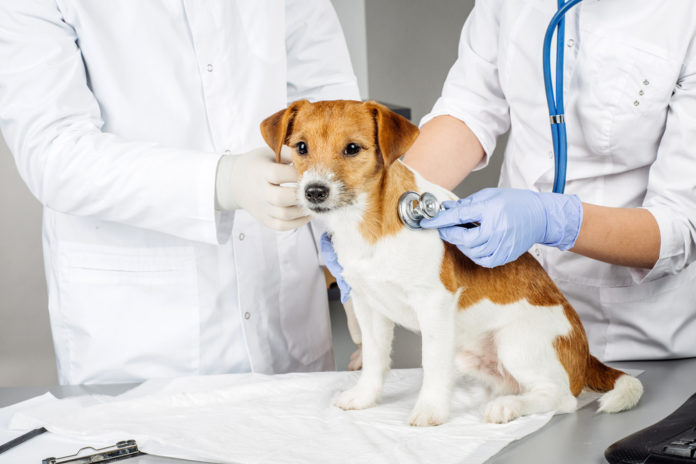Cancer tests for dogs and cats

An early diagnosis can mean the difference between life and death for animal cancer patients. Learn how a blood profile and ultrasound can help catch signs of inflammation or malignancy before your dog or cat gets sick.
It seems hardly a day goes by that I’m not asked to consult on a cancer case. Clients come to me to see if there are any alternatives to conventional cancer treatment (there are many), or if supporting their dogs’ or cats’ immune systems might help them recover from or even be cured of their cancers. While I love treating animals with cancer, I love preventing it even more. And when I can’t prevent it, I like to diagnose it early, before the animal becomes ill and cure may become impossible. In this article, I’ll share some tests that allow for early cancer diagnosis, in the hopes you might be able to save your own dog or cat from this devastating disease.
There are two basic categories of cancer testing. The first involves simple and inexpensive blood testing done at least every six months (more often if the testing is abnormal). The second category is ultrasound testing, also done every three to six months.
1. Blood testing for inflammation/oxidation/early cancer
Several tests are done as part of a blood profile to detect occult cancer or the predisposition to develop cancer. The cancer/inflammatory profile I use checks for three biomarkers — CRP, TK and vitamin D-3.
- CRP, or C-reactive protein, is produced by the liver and increases when there is inflammation throughout the body. CRP is one of the acute phase reactant proteins that go up in response to inflammation. Basically, when white blood cells called macrophages and T cells are stimulated, they produce cytokine chemicals such as interleukin-6, which stimulates the liver to make more CRP.
Various inflammatory conditions such as cancer and heart disease, traumatic injury to tissue, hard and constant exercise, and cell death can increase CRP levels, but infections with bacteria and fungi can also stimulate synthesis. (In people, but not dogs, fat cells stimulate increased levels of CRP; increased body weight is a common cause of low grade inflammation in people, predisposing them to inflammatory disorders.)
CRP rises within two hours of the onset of inflammation and peaks at 48 hours. Its half-life in people is about 18 hours; in dogs, elevated CRP levels are present for about one to two weeks following the initial insult. Dogs with increased CRP levels have something causing inflammation internally, and further testing is needed. Because cancer rates are increasing in animals, I recommend further investigation to rule it out. If cancer is detected, it is likely caught at a very early stage and treatment may lead to cure. If no cancer is detected, the CRP levels are normalized via various herbs and supplements and the animal is maintained on the therapy to keep inflammation in check. Ongoing monitoring is done as needed to make sure cancer does not develop.
In my practice, about half the normal dogs we test have increased levels of CRP (virtually all dogs with obvious inflammatory diseases show high levels). When I find an increased CRP level, it indicates excessive inflammation somewhere in the body. If the levels are mildly elevated, I will usually treat these animals with anti-inflammatory doses of herbs, fish oil or both. Following this treatment, patients are maintained on supplements and closely monitored for any indication that CRP levels (or TK levels, see below) are increasing, at which point more testing may be needed. Dogs with very high CRP levels need more immediate evaluation that may include cultures, specialized blood tests for infectious diseases, and radiographs and ultrasound examination to look for tumors and abscesses.
- TK (thymidine kinase) is an enzyme that rises with inflammation, specifically with diseases such as cancers and certain infectious disorders (e.g. rickettsial diseases such as Rocky Mountain spotted fever, transmitted by ticks.)
- Vitamin D is often at low levels in the general population and predisposes the animal to developing both inflammatory diseases (such as cancer) and infectious diseases (kennel cough, dog flu, etc.) In my own practice, the majority of normal dogs tested have increased TK, CRP — and/or low vitamin D levels. In fact, over 90% are low on vitamin D because dogs do not make this vitamin from sunlight and diets are too low in D to produce high enough blood levels to be considered “healthy”.
In my practice, 100% of dogs with cancer have low vitamin D3, again showing how important testing is and how essential it is to normalize D3 levels. Animals and people with normal vitamin D3 levels are less likely to have cancer. Vitamin D supplementation is needed for those with low blood levels of vitamin D, and supplementation is used based on the animal’s weight and health condition as well as the vitamin’s blood level.

2. Ultrasound examinations for early cancer diagnosis
Another series of tests for early cancer diagnosis involves ultrasound examinations of the chest and abdominal cavities. Ultrasound uses harmless soundwaves to form a computerized picture of the body’s organs.
I like using ultrasound examinations to look for solid tumors, particularly of the liver, spleen and heart. The tumor of most interest is hemangiosarcoma, a very common abdominal and less common chest cancer. In my practice, we also often find problems we weren’t even looking for, such as bladder stones or various disorders of the gallbladder and adrenal glands. Finding both cancerous and benign tumors on the ultrasound exam allows us to treat and possibly cure the animal at an early stage.
It’s an exciting time for animal lovers and veterinarians because so many advances in healthcare allow for the early diagnosis, treatment and even cure of cancer and other diseases. In fact, I think early testing for cancer is a much better use of funds than unnecessary vaccinations, drugs and chemicals.



